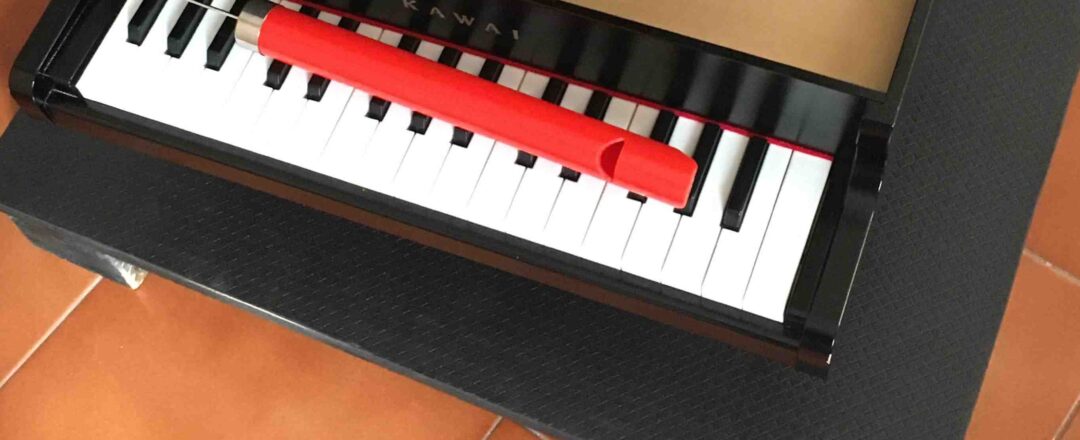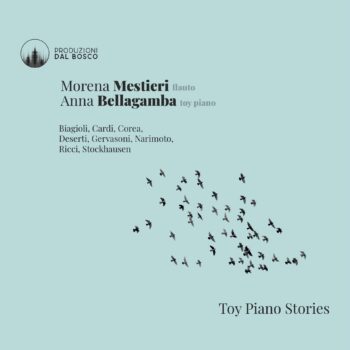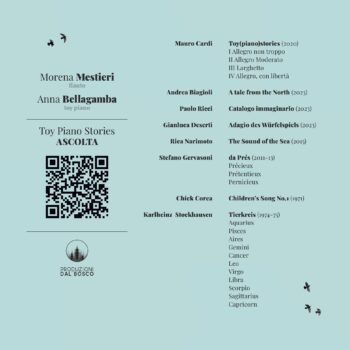Released in October 2023, the CD Toy piano stories is produced in a digital-only edition by Produzioni dal Bosco, an independent record production label immersed in the woods of the Tuscan-Emilian Apennines.
In this CD, Ecoensemble Duo explores the expressive possibilities of the flute and toypiano duo, also contributing to the expansion of the repertoire with a group of new compositions by Italian composers: Toy (Piano) Stories by Mauro Cardi, which gives the CD its title, A Tale from the North by Andrea Biagioli, Catalogo immaginario by Paolo Ricci and Adagio des Würfelspiels by Gianluca Deserti.
These are joined by The Sound of the Sea by Japanese composer Rica Narimoto, and an original transcription for alto flute and toypiano of one of Chick Corea's Children's Songs.
Instead, the three Prés (Précieux, Prétentieux and Pernicieux) by Stefano Gervasoni, originally written for toypiano even though they are included in the larger collection Prés for piano, are for toypiano only.
Finally, a new version of Karlheinz Stockhausen's famous Tierkreis (Zodiac) completes the programme, in which the crystalline timbre of the toypiano seems to take us back to the original 1975 version for carillons, while the flute multiplies with the help of piccolo, alto flute and bass flute, and seems to embrace and support, with its wide extension and rich expressive capacity, its little travelling companion.
LISTEN to Toy piano stories
on all digital platforms
Mauro Cardi - Toy(piano)stories (2020)
Andrea Biagioli - A tale from the North (2023)
Paolo Ricci - Catalogo immaginario (2023)
Gianluca Deserti - Adagio des Würfelspiels (2023)
Rica Narimoto - The sound of the Sea (2015)
Stefano Gervasoni - from Prés (2011-13) Précieux, Prétentieux, Pernicieux
Chick Corea - Children’s Song No.1 (1971)
Karlheinz Stockhausen - Tierkreis (1974-75)
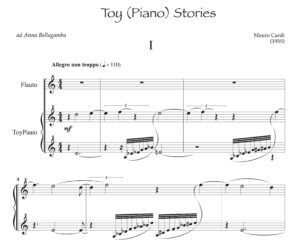
Toy (Piano) Stories is part of the series Games, compositions in which play, intended in its widest sense, is an integral part of the compositional structure. This piece is, however, different from the three previous numbers in the series, all for homogeneous ensembles, in which symmetry and specularity are the elements that immediately jump out at the spectator, made evident by the particular form of the score and the very movements required of the performers. In Toy (Piano) Stories, instead, the protagonist is a toy, the toypiano, which interacts with four different flutes, flute in C, alto flute in G, slide flute and piccolo, playing a different part each time.
MORE
LESS
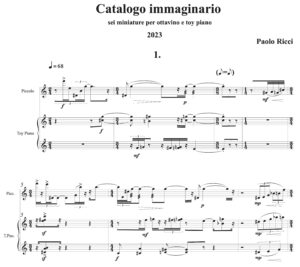
I warmly welcomed Ecoensemble Duo's request to write a piece for flute and toy piano because, having already composed three other pieces using the toypiano, I can consider myself (self-ironically) a 'specialist' of this instrument. And also because, in combination with the flute, it seemed to me a particularly fortunate stimulus, rich in timbral possibilities and colouristic suggestions. The choice, then, to opt for the piccolo flute added a sense of (almost) childlike fun to the whole operation.
MORE
LESS
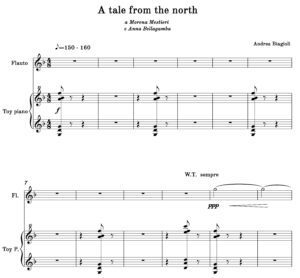
A Tale from the North arose from vague memories of traditional Celtic melodies heard while staying in Ireland during adolescence. The flute begins imitating the traditional 'whistle' of those places, punctuated by the toy piano delineating the contours. Gradually, the memory takes shape until it emerges into a real theme that is quite distant from the original, only to dissolve back into the textures of the toy piano.
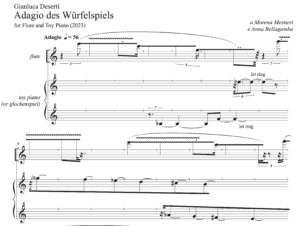
Adagio des Würfelspiels, for flute and toypiano, was composed in 2023 at the invitation of Ecoensemble Duo, to be presented at Festival miXXer, where the piece had its first performance. As the title itself suggests, the piece was inspired by Mozart's Musikalisches Würfelspiel, a system of musical composition based on the use of dice and predetermined patterns. The game consisted of two dice to be thrown in order to obtain a random numerical sequence to which musical beats corresponded according to an order number in special tables, arriving at a combinatorial recomposition of the measures indicated by the composer. A minuet of sixteen measures, obtained from some of the possible combinations envisaged by Mozart, gave rise to the material underlying the composition.
MORE
LESS
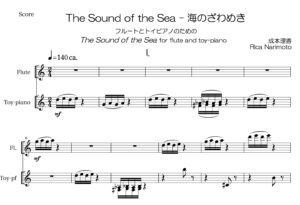
The Sound of the Sea was composed for a concert featuring works inspired by the sea and water at MEGI HOUSE, an art space on Megijima Island in the Seto Inland Sea of Japan in 2015.
In this piece, a flute and a toy-piano were used to represent various sounds coming from the sea. I composed this piece while thinking of the sound of waves, sea foam, fish jumping, and the murmur of the surface of the sea, as well as the faces of the children who would attend the concert, hoping to create a lovely piece.
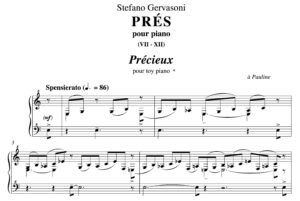
Prés is a cycle of eighteen pieces, divided into six groups of three. Their main characteristics are brevity and simplicity (more or less apparent), making them belong to the category of pieces for children (in the twofold and ambiguous sense of being performable by non adult pianists or taking their inspiration from the world of childhood). Eighteen small préludes, so small as to merit the name prés, that is “meadows” in French. Thence the underlying theme of the cycle, portrayed in six different ways, three pieces for each one: the apparent carefree atmosphere of a meadow where children play and the premonition of something bad that is about to happen and that the innocent gaze of a child is able to perceive beforehand, with all the sense of foreboding that an adult cannot or doesn’t want to comprehend.
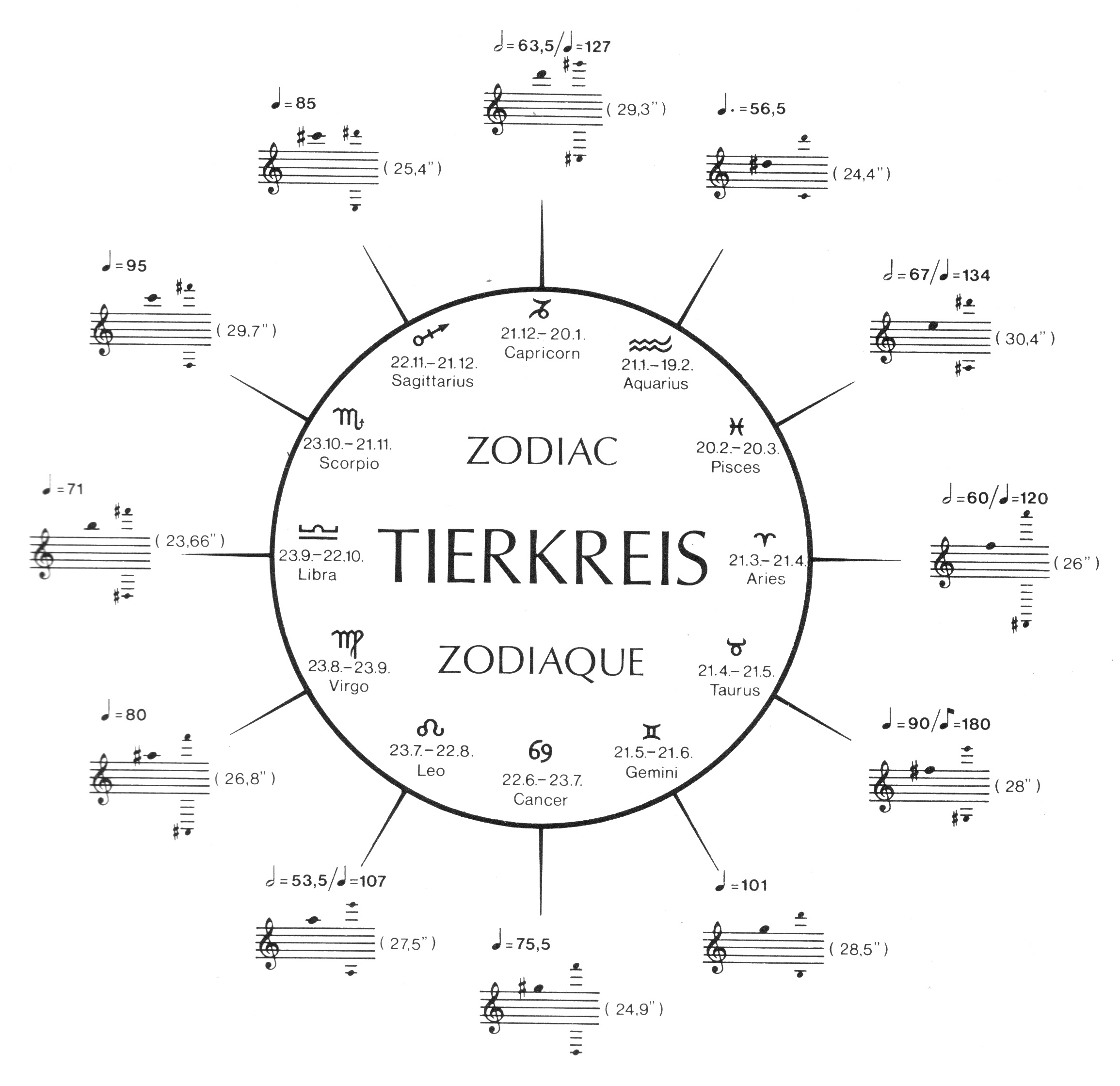
The twelve melodies of Tierkreis (Zodiac), one for each sign of the zodiac, were composed by Stockhausen in 1975 for Musik im Bauch (Music in the Belly), and in that context were intended to be performed by twelve music boxes.
Each melody is composed in such a way that it must be repeated at least three times, with variations at each repetition. The performers have complete freedom in the choice of variations, but their purpose must be merely to make the internal structure of the melody clear and to emphasise its particular characteristics.
Stockhausen writes: 'In composing each melody, I thought about the character of children, friends, acquaintances born under the various signs of the Zodiac, and I studied the different human types in depth. Each melody is composed, in form and proportion, in accordance with the character traits of the corresponding zodiac sign, and this will become clear if one listens to each melody several times and considers its structure carefully."
Ecoensemble has produced a version of Tierkreis for flute in C, piccolo, alto flute, bass flute and 32-key toypiano for this CD.
